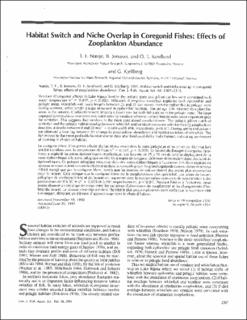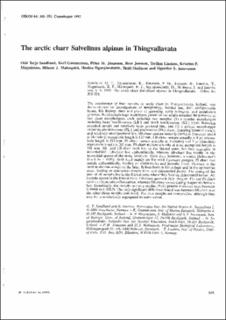| dc.description.abstract | SYNOPSIS OF RESULTS
Ontogenetic niche shifts
Papers I, II, III, IV, VIII, and IX show that both vendace, whitefish and Arctic charr perform ontogenetic niche shifts. All species start their lives in the benthic zone and turn to utilizing the pelagic zone at a later age.
In vendace, the whole cohort performs a niche shift to the pelagic zone during the first summer (Paper II), and continue living in this zone feeding mainly on zooplankton for the rest of the life span (Paper IV and VII). Even in the littoral zone, however, the diet of age-0 vendace is dominated by crustacean zooplankton (Paper II). Thus, the niche of vendace is narrow, and the specialist nature of the species is reflected in its pelagic zooplanktivore life in a variety of localities (Paper IV, V, VII). The observed fluctuating or regularly oscillating year class strengths in vendace populations (Paper VI) are probably due to the narrow niche of the species, restricted both in the diet and habitat dimension, creating strong intra-specific interactions.
The generalist nature of Arctic charr and whitefish is indicated by their variable diet and habitat use within and between lakes. The two species resemble each other in their patterns of ontogenetic niche shifts. Populations of both species maintain a basis in the epibenthic habitat, where all size groups of the population usually are present (Paper III, VIII, IX). Among certain size groups, some fish perform a seasonal habitat shift to the pelagic zone when zooplankton abundance is high. In Mjøsa whitefish, the habitat shift occurs just prior to sexual maturity at a size of 25 cm (Paper III and IV). In Femund whitefish, the habitat shift occurs at a size of between 20 - 25 cm (Paper VIII), and is mainly performed by the most slow-growing morph, which matures sexually from a body length of 25 cm onwards. In both lakes the habitat shift involves few fish larger than 35 cm, and only a part of the 25 - 35 cm length group. The change in habitat may therefore be termed niche expansion rather than niche shift. In Mjøsa, the niche of whitefish larger than 35 cm is restricted to feeding in the deep benthic zone on one particular prey item (Pallasea quadrispinosa). In Femund, large whitefish utilize the shallow benthic zone (Paper VIII, Sandlund and Næsje 1986).
The ontogenetic development of the niches differs among the Arctic charr morphs in Thingvallavatn (Paper IX). All morphs start their lives in the littoral zone, feeding mainly on chironomid larvae. The benthic morphs remain in the littoral zone, but their diet includes an increasing proportion of the snail Lymnaea peregra. Thus, there is a rather moderate niche change in the benthic morphs (SB- and LB-charr). The pelagic morphs, on the other hand, expand their habitat to include both the profundal and the pelagic zone, and their diet includes both zoobenthos and zooplankton, from an age of a few months onwards. The large pelagic morph (LP-charr) performs one additional diet shift, into a diet dominated by fish (Gasterosteus aculeatus). In this system, the pelagic morphs (PL- and Pl-charr) exhibit generalists’ niches, whereas the benthic morphs (SBand LB-charr) are more specialized.
The dominance of pelagic prey in the diet of pelagic whitefish (Paper II and III) and Arctic charr (Paper IX), indicates that the individual fish stay for a prolonged period in the pelagic zone. This observed pattern of niche shifts generates the hypothesis that the individuals performing the niche shift are morphologically and behaviourally better adapted to a pelagic life than the individuals remaining in the benthic habitat.
Polymorphism
Superficially, the occurrence of polymorphism in whitefish and Arctic charr populations does not seem to increase total population niche width. For instance, the Mjøsa whitefish (Papers I - V) utilize all main habitats (littoral, profundal, pelagic) and all prey types and sizes commonly taken by whitefish, during its lifetime. The Femund whitefish, which according to gillraker number consists of three morphs (Paper VIII), appears to use the same habitats. However, a closer analysis of the niche of each ontogenetic stage reveals differences between mono- and polymorphic stocks. E.g., the niche of juveniles is wider in polymorphic than in monomorphic whitefish populations. In Femund, juveniles were caught in the benthic zone at all depths down to 60 m (Paper VIII, Sandlund and Næsje 1986), indicating a wider habitat than among juveniles of the monomorphic Mjøsa stock, which are restricted to the littoral zone (Paper II, III).
In the Thingvallavatn charr, the variation in habitat use and diet among the morphs, already from age-0, leads to a very wide total niche for this population (Paper IX). Within virtually all size and age groups of fish there are both pelagic and benthic fish. The diet of all size groups between approximately 7 - 22 cm varies from crustacean zooplankton through insects to snails. The diet of fish larger than 22 cm also includes fish.
The observations on head morphology and gillraker number of the pelagic versus the benthic morphotypes in Thingvallavatn (Paper IX) support the notion that sympatric morphs are morphologically specialized to feed on different prey types in different environments. Trophic specialization makes each fish more efficient in utilizing its special resource. A condition for the occurrence of trophic specialization, however, is that there are stable resource bases available. In Thingvallavatn these bases of available resources largely consists of the snail Lymnea peregra in the benthic zone, the crustacean zooplankton and the emerging and hatching chironomids in the pelagic zone, and the sticklebacks in the epibenthic zone. The nearly complete absence of competitors has allowed for a trophical diversification and specialization in the Arctic charr population.
In Femund, the number of competitors is also relatively low, and the whitefish has diversified into morphs differing in trophical morphology (Paper VIII). The three morphs have been denoted according to their spawning sites: deepwater (D-), river (R-), and shallow water (S-) whitefish. In this case the morph with the lowest number of gillrakers, i. e. the D-whitefish (28 gillrakers), utilize the pelagic zone during the period of maximum zooplankton abundance. The morphs with the denser giilraker sieves (Rwhitefish, 35 gillrakers; S-whitefish, 43 gillrakers) mainly stay in the benthic habitat. This may indicate that the connection between zooplanktivory and the number of gillrakers is not as simple as has been believed (Nikolsky 1963, Lindsey 1981, but see O’Brien 1987). The zooplankton size selection by vendace and whitefish in Mjøsa shown in Paper V also indicate a more complex connection between giilraker morphology and zooplanktivory than is often believed.
It may be hypothesized that some of the differences between whitefish morphs in Femund emerge because the morphs spawn in widely different environments (Paper VIII). The hatching larvae will consequently experience different physical environments and probably different types and abundances of prey. The fact that D-whitefish has a slower growth rate and a smaller asymptotic size than the two other morphs might indicate that fish of the different morphs experience different environments for a prolonged period of time. Thus, other selection pressures of more vital importance than zooplanktivore efficiency in subadult or adult life may cause the giilraker divergence among the whitefish morphs in Femund.
Polymorphism and fish community structure
In temperate lakes, most invertebrate prey available to fish occur in a seasonal manner (Paper III, IV, IX), so that each fish to some degree has to shift from one prey type to another. In Mjøsa, there are in all habitats some species that are trophically more specialized than whitefish (Paper I). Thus, the possible use by whitefish of each habitat is probably restricted. Generalists like whitefish are able to balance this drawback by shifting between prey types and habitats both seasonally and through life (Paper II, III,
IV), and no trophic specialization will occur in terms of e.g. polymorphism.
Paper I shows that the habitat of monomorphic whitefish overlap with several of the other dominant species in Mjøsa. In the littoral zone, both perch (Perea fluviatilis) and roach (Rutilus rutilus) are numerous. Ruffe (Acerina cernua) has a benthic habitat that overlaps with the benthic whitefish population, and smelt (Osmerus eperlanus) has both a benthic and pelagic habitat, which is similar to that of whitefish. Thus, an extensive coexistence with many species appears not to restrict the habitat dimension of the age-structure component of the niche of the whitefish. The niches of polymorphic stocks are, however, expanded by means of the between-phenotype component.
The polymorphic stocks of whitefish (Paper VIII) and Arctic charr (Paper IX) treated in my investigations are both found in localities with low fish fauna diversity and diverse feeding and spawning habitats. | en_US |


